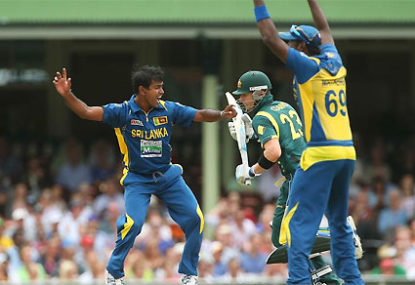There has been a lot of talk lately that the 50 over format of cricket is dying, and needs to be killed off. I couldn’t disagree more. The 50 over format, unequivocally, needs to stay.
Not because its crowds are great. Not because it rates through the roof on TV. Not because sponsors love it. Not because India won’t allow it to die.
Sure, all those variables matter and come into play when discussing the 50 over game’s future viability; however, I believe it needs to stay for the greater good of cricket itself.
The 50 over game, if nothing else, is the perfect bridge between first class and T20 cricket. Without 50 over cricket, the gap between first class and T20 is far, far too great, especially for batsmen.
50 over cricket is a great way for traditional first class batsmen to develop more attacking shots and the confidence to play them, along with learning how to increase the pace of their innings when required, without the pressure of trying to hit boundaries from ball one, as per T20.
Meanwhile, for the youngsters coming through, brought up on a diet of T20 cricket, the 50 over game is an ideal way to learn how to construct a longer innings, while not sacrificing their attacking flair.
The difference between a first class batsman and T20 batsman shouldn’t really be that large, as normal cricket shots remain the best reward in both formats. But it’s the mentality when taking strike, and the definition of success, that differ between the two formats.
If a batsman scores 40 off 20 balls in T20, then throws his wicket away recklessly, he’ll probably still be in contention for the man-of-the-match award. Conversely, in Test cricket, he may find himself dropped for the next game.
Batsmen need to be able to re-adjust between first class and T20 cricket, and the 50 over game helps them do that.
While I concede we are talking about professional cricketers, who should be able to easily adjust their playing style, it can be difficult to do so when they’ve been playing a certain way as habits and instincts kick in. However, playing all three formats enables players to get a better feel for their different ‘gears’, for lack of a better word.
There are subtle differences between the three formats, but if you take away the 50 over game, the differences between first class and T20 become extremely pronounced.
It’s the equivalent of removing a rung on a ladder. Can you still climb up and down? Yes, but it does make it more difficult.
Therefore, removing what some have called the ‘middle child’ essentially pulls first class and T20 cricket even further apart.
Some will not see a problem with that, as they almost consider the two formats as different sports, and would be quite pleased to see them separated further. It’s often been opined that Test players shouldn’t play T20, and vice versa.
While I can understand that mentality, I don’t necessarily agree with it. But more important than anything I believe is the fact it’s simply not realistic.
Apart from the point that most cricketers love the game and want to play as much as possible – regardless of format – players simply cannot ignore the financial incentives available in the shortest form of the game.
Like it or not, T2O provides a chance for cricketers to earn big and (relatively) easy coin.
That’s not to say Test cricket doesn’t provide the same financial opportunities. I can assure you that Australia’s Test cricketers are not residing on Struggle Street, and almost all of them, perhaps surprisingly, earn more from their Test careers than they do from T20.
But unlike the Australian Test team, there are more than 11 T20 spots available around the globe, which gives the impression, real or not, that the money available in the 20 over game is more attainable.
It’s also worth noting that two of Australia’s Test players, Dave Warner and Nathan Lyon, actually earned their baggy green primarily off their exploits in T20 cricket.
In any case, this is not a piece about T20 cricket and defending it. It is a realisation that T20 is not going anywhere anytime soon and batsmen, in particular, are going to want to play it.
With that in mind, there needs to be a discussion and understanding on the optimal number of cricket formats. Which I categorically believe is three.
Without the 50 over game, the gap between first class and T20 would be too large and, at the risk of sliding into hyperbole, it may end up severely damaging the two remaining formats, and therefore cricket overall.





























































































